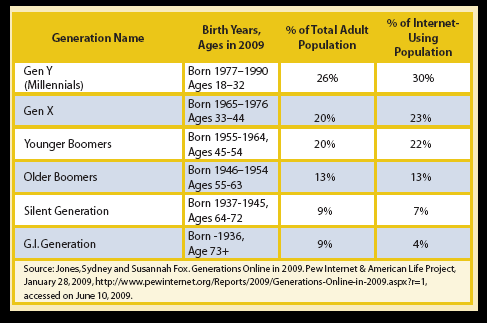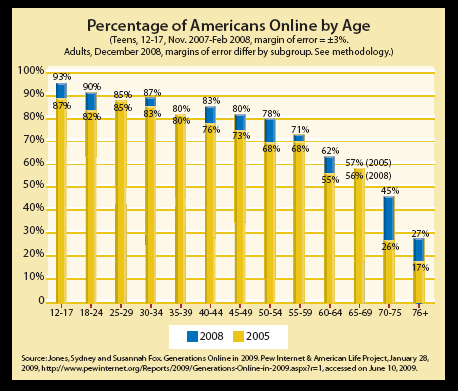It’s official! According to the Pew Internet & American Life Project report “Generations Online in 2009,” authored by Sydney Jones and Susannah Fox, a significant number of the Silent Generation and younger members of the G.I. Generation are finally using the Internet and e-mail.
While it is true that members of younger generations (including Gen Y, Gen X, and younger Boomers) use the Internet at a greater rate than older generations (including older Boomers, Silent Generation, and G.I. Generation), there has been a marked shift in online use and activities among older adults in just the last few years.
Pew researchers have found that “even Silent Generation Internet users are competitive when it comes to e-mail (although teens might point out that this is proof that e-mail is for older people).”
The impact of these changes is likely to have far-reaching effects on all types of fund-raising activities, but especially so on those responsible for planned and major gift development.

Many of the prospects for such gifts are among the relatively late adopters of this technology, so marketing techniques may have to change accordingly. An understanding of the recent changes in the use of the Internet by various generations of donors may help fund raisers be more effective with the development of generationally appropriate tactics and strategies.
According to Pew, the biggest change in Internet usage since 2005 can be seen among the 70 to 75 and 76+ year-old age groups. These two groups have had over a 60% increase in Internet use, even though their usage is still lower than all other age groups.

In fact, over 45% of those in the 70 to 75 age group report actively using the Internet. In 2005, only 26% of this demographic acknowledged frequent Internet activity.
Among older Internet users, e-mail is the most popular online activity. Almost 75% of Internet users who are at least age 64 use e-mail. The older generations also use the Internet as a research tool for various types of health and financial information. The Pew research found that e-mail and online searches were the two most popular online activities for the most senior groups of Internet users.
While social-networking sites such as Twitter and Facebook have surged in popularity among younger Internet users (67% of those 18-32 report using them), they have not gained traction among older users. In fact, only 4% of Internet users who are over 73 report visiting such sites.
Note too that only 16% of the oldest Internet users report having broadband Internet access at home. A high-speed connection makes it far more convenient to access the Internet. Seniors without high-speed access are less likely to participate in many online activities. This should be taken into account when offering opportunities for seniors to download large files or other “broad-band intensive” applications.
To learn more about Internet use among different age groups and view “Generations Online in 2009” in its entirety, visit the Pew Internet & American Life’s Web site at www.pewinternet.org.

The take-away
As the Internet becomes an even more pervasive element in American life, more and more Americans will conduct many of their daily routines online. Within the next few years, increasing numbers of retiring Boomers will take with them the computer skills they learned while in the work force. As they do so, expect the number of Internet-savvy seniors to rise sharply.
For now, in spite of the fact that the Silent and G.I. Generations still have a lower overall rate of Internet use, these two groups of late adopters have reached what many consider a “tipping point” in terms of access and usage. Fund raisers would be well advised to review and revise Internet strategies for planned and major gift development purposes.
Having a planned giving Web site or page(s) is not the same thing as having a strategy. Does your organization have a plan that makes sense? Can you articulate the goals and objectives for the planned giving component of your Web site? Are the existing materials dynamic and interactive, or static? What are your donors’ expectations concerning privacy? What do you think they would say about the use of spyware or tracking donor-specific activity on your Web site? Consider how older Boomers and the Silent and G.I. Generations use the Internet and make sure that your Web-based gift development strategies are in synch with their current and future usage.
Note: The Sharpe Group now offers SharpeNet Web Services—Web That Works, an exciting new way to reach the growing number of Internet-savvy seniors. To learn more about SharpeNet Web Services, contact a Sharpe representative at 1-800- 238-3253, e-mail info@sharpenet.com, or visit www.sharpenet.com/web.

